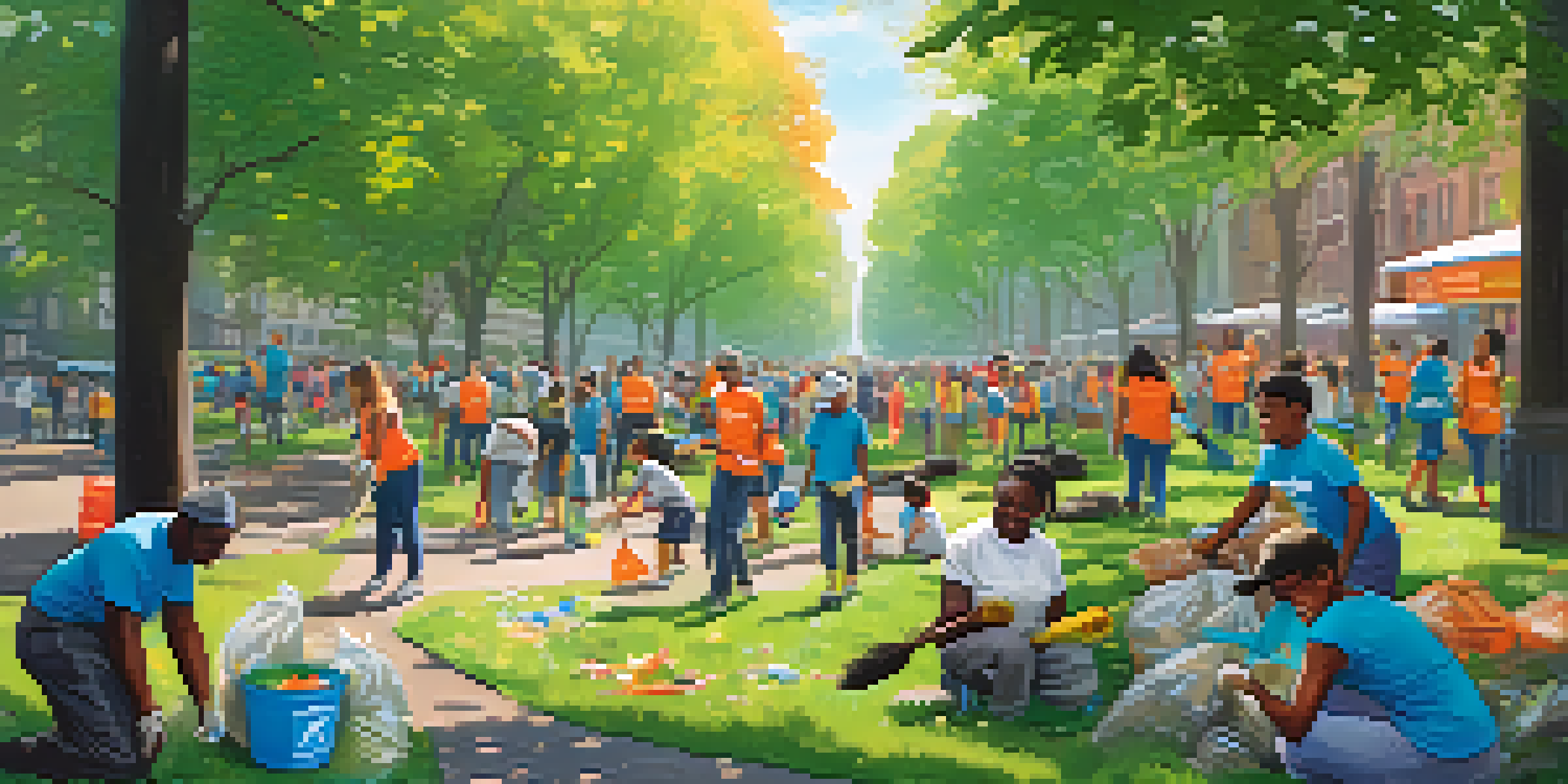How Volunteerism Strengthens Neighborhoods in NYC

The Heartbeat of NYC: Community Engagement Through Volunteerism
Volunteerism serves as the heartbeat of New York City's vibrant communities. When residents come together to lend a hand, they build connections that strengthen the social fabric of their neighborhoods. This collective effort not only supports local initiatives but also fosters a sense of belonging among diverse populations.
Volunteering is at the very core of being a human. No one has made it through life without someone else’s help.
By engaging in volunteer activities, individuals from different backgrounds unite over shared goals. For instance, community clean-up events can bring together families, students, and seniors, all working side by side for a cleaner environment. This collaboration sparks conversations, friendships, and networks that last well beyond the event.
Moreover, these interactions create a ripple effect—encouraging others to join in and contribute. As more people participate in volunteerism, the community becomes more resilient, ready to tackle challenges together, whether that’s organizing food drives or supporting local shelters.
Creating Safe Spaces: How Volunteers Enhance Neighborhood Safety
Safety is a fundamental concern for any community, and volunteerism plays a crucial role in creating safer neighborhoods. When residents take the initiative to form watch groups or organize safety workshops, they empower themselves and their neighbors. This proactive approach fosters a sense of security that makes everyone feel more at home.

For example, neighborhood patrols can deter crime while building trust within the community. Volunteers often know their area well and can identify unusual activities, alerting authorities when necessary. Such vigilance not only enhances safety but also cultivates a culture of care and responsibility among residents.
Volunteerism Strengthens Community Bonds
Engaging in volunteer activities fosters connections among residents, enhancing the social fabric of neighborhoods.
Additionally, volunteers can organize self-defense classes or safety seminars, equipping community members with skills and knowledge. These efforts not only improve individual safety but also strengthen community bonds, as people come together to learn and support each other.
Bridging Cultural Gaps: Volunteerism in Diverse Communities
New York City is a melting pot of cultures, and volunteerism serves as a bridge across these diverse backgrounds. Through volunteering, individuals can share their unique perspectives and traditions while learning about others. This exchange fosters mutual respect and understanding, enriching the community as a whole.
The best way to find yourself is to lose yourself in the service of others.
Take, for instance, cultural festivals organized by volunteers that showcase food, art, and music from various cultures. Such events not only celebrate diversity but also invite community members to engage with different customs. This engagement naturally breaks down barriers and creates a welcoming environment for all.
Moreover, volunteerism allows for mentorship opportunities between different generations and cultures. Older residents can guide younger ones, sharing their experiences, while newcomers can bring fresh ideas and energy. This intergenerational collaboration empowers everyone involved and strengthens the communal bond.
Empowering Youth: Volunteerism as a Tool for Development
Volunteering provides invaluable opportunities for youth to develop essential skills and gain experience. When young people participate in community service, they learn teamwork, leadership, and problem-solving—skills that serve them well in future endeavors. This hands-on experience can be a game-changer in shaping their futures.
For example, local organizations often host youth-led initiatives, such as tutoring younger students or organizing charity events. These projects not only benefit the community but also instill a sense of pride and accomplishment in the youth involved. They begin to see their potential and the impact they can have on their surroundings.
Safety Through Community Engagement
Volunteers play a vital role in enhancing neighborhood safety by forming watch groups and organizing safety workshops.
Additionally, volunteerism can help youth create lasting connections with mentors and peers. These relationships can provide guidance and support, opening doors to educational and professional opportunities. As they grow, these young volunteers may become champions of their communities, inspiring future generations to get involved.
Building Local Economies: Volunteerism and Economic Growth
Volunteerism can significantly contribute to the local economy by supporting small businesses and community initiatives. When volunteers help organize events like farmers' markets or street fairs, they create opportunities for local vendors to thrive. This not only boosts sales but also fosters a vibrant community atmosphere.
Moreover, volunteers often invest their time in promoting local causes, such as food banks or shelters, which can enhance community well-being. By addressing social issues, volunteers help create a healthier, more stable environment that attracts businesses and residents alike. A thriving community is one where everyone feels supported and invested in.
Additionally, volunteerism can lead to job creation. When community projects gain traction, they may require staff or additional resources, leading to new employment opportunities. This cycle of support and growth contributes to a sustainable local economy that benefits all residents.
Fostering Environmental Stewardship Through Volunteerism
Environmental issues are increasingly at the forefront of community concerns, and volunteerism is a powerful tool for fostering stewardship. Through activities like tree planting, community gardens, and park clean-ups, volunteers take an active role in preserving and enhancing their environment. This hands-on approach makes a tangible impact that residents can see and appreciate.
For example, community gardens not only beautify neighborhoods but also provide fresh produce to those in need. When residents come together to cultivate these spaces, they learn about sustainability and the importance of local food sources. This knowledge empowers them to make environmentally conscious choices in their daily lives.
Youth Development via Volunteerism
Volunteering provides youth with essential skills and experiences that empower them to positively impact their communities.
Moreover, engaging in environmental volunteerism can inspire a collective responsibility towards nature. As community members witness the positive effects of their efforts, they are more likely to advocate for policies that protect the environment. This shift in mindset can lead to lasting changes in how a community interacts with its surroundings.
The Lasting Impact of Volunteerism on Community Identity
Volunteerism plays a pivotal role in shaping a community's identity and values. When residents actively participate in initiatives that resonate with their beliefs, they contribute to a shared mission that defines their neighborhood. This sense of purpose can elevate community pride and encourage further engagement.
For instance, a neighborhood that rallies around a common cause—such as supporting local schools or preserving historical sites—creates a lasting legacy. Volunteers who invest their time and energy in these efforts become ambassadors of their community. Their passion and dedication can inspire others to join, creating a cycle of support and growth.

Ultimately, the impact of volunteerism goes beyond immediate results; it cultivates a culture of care and collaboration. As community members unite to tackle challenges and celebrate successes, they forge a strong identity that reflects their shared values. This collective spirit not only enhances the neighborhood but also enriches the lives of everyone involved.